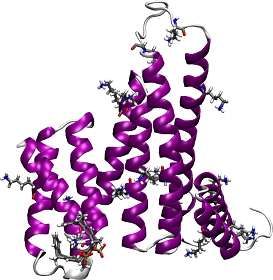Tiny tweezers and their big influence on bustling proteins: Scientists investigate molecular 'clothespins'

(Phys.org)—Tiny molecular tweezers have a remarkable impact on bustling proteins: Three research groups from the University of Duisburg-Essen (UDE), the Chemical Genomics Centre of the Max Planck Society in Dortmund and the Max Planck Institut für Kohlenforschung in Mülheim found that the molecular tweezers designed by Professor Frank Klärner at the UDE can be used to regulate protein - protein interactions by selectively trapping certain residues of the protein – and stick like a clothespin. The research groups of Thomas Schrader (UDE), Christian Ottmann (Chemical Genomics Centre) and Elsa Sanchez Garcia (MPI für Kohlenforschung) believe that this might be a promising approach for applications in medical research, as the water soluble tweezers act without inducing toxicity or explicit side effects.
The scientists have tested their small tweezers on proteins that have influence on many processes in the human body. "We also wanted to know how they work", says Dr. Elsa Sanchez Garcia, leader of a Max Planck research group at the Max Planck Institut für Kohlenforschung. The chemists have found out that although their tweezers prefer to bind at the amino acid lysine, the protein surrounding of the lysine influences the trapping of the tweezers. Thus, with computer simulations Dr. Sanchez Garcia and her colleague Kenny Bravo Rodriguez have shown which type of lysine the tweezers prefer – and why that is the case. Their work also allowed to lay down rules for predicting the behavior of the tweezers in the presence of proteins with several lysine residues.
Although the tweezers research is at early stages, their potentiality makes it worth for medical researchers to have a closer look at these results. The 14-3-3 adapter proteins (14-3-3) that the scientists used for their experiments are small recognition proteins that influence many physiological processes by binding their targets via short peptide sequences and modulating their function. For instance, they are able to stabilize certain tumor suppressors. Because of their important role in many biological processes, 14-3-3 proteins are prospective therapeutic targets against severe disorders, such as cancer.
The three research groups published their findings in the Nature Chemistry magazine.
More information: www.nature.com/nchem/journal/v … full/nchem.1570.html
Journal information: Nature Chemistry
Provided by Max Planck Society
















